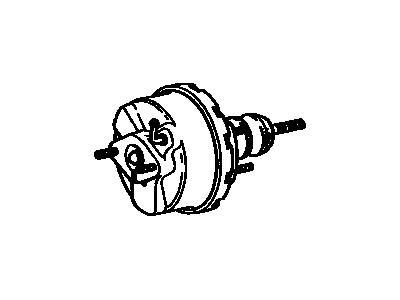This part fits the vehicle you selected:
My Vehicle: 5TELU42N56Z291220 2006 Toyota Tacoma United States Of America; 6 Cyl 4.0L DOHC EFI; Base; 5-Speed Automatic Transmission; Double Cab; GRN245L-PRADKA
Change VehicleThe vehicle options this part fits:
- Production Date: 04/2006-05/2008
- Fitting Vehicle Options: GRN245, 250, 265, 270
Toyota 44610-04161 Booster Assembly, Brake
2006-2009 Toyota Tacoma 4461004161

- Part DescriptionBooster Assy, Brake
- Part Name Code44610
- Replaced By44610-04162
- ManufacturerToyota
This part fits the vehicle you selected:
5TELU42N56Z291220 2006 Toyota Tacoma United States Of America; 6 Cyl 4.0L DOHC EFI; Base; 5-Speed Automatic Transmission; Double Cab; GRN245L-PRADKA
The vehicle options this part fits:
- Production Date: 04/2006-05/2008
- Fitting Vehicle Options: GRN245, 250, 265, 270
$622.51 MSRP: $916.33 1
You Save: $293.82 (33%)
Ships in 1-3 Business Days
Product Specifications
| Brand | Genuine Toyota |
| Part Name Code | 44610 |
| Manufacturer Part Number | 44610-04161 |
| Part Description | Booster Assy, Brake |
| Item Dimensions | 16.1 x 12.6 x 12.4 inches |
| Item Weight | 7.40 Pounds |
| Condition | New |
| Fitment Type | Direct Replacement |
| Manufacturer | Toyota |
| SKU | 44610-04161 |
| Warranty | This genuine Toyota part is guaranteed by Toyota's factory warranty. |
| Shipping & Return | Shipping Policy Return Policy |
Warning: California’s Proposition 65
Customer Questions & Answers
- Q:Is the above part number correct or is there another correct number for my car? Posted by ToyotaPartsDeal Specialist
- A:You can Select Your Vehicle to check if 44610-04161 fits your vehicle.Posted by ToyotaPartsDeal Specialist
- Q:How to check and replace a power brake booster on 2005 through 2009 Toyota Tacoma? Posted by Customer
- A:To ensure the proper functioning of your power brake booster and maintain air tightness in the system, follow these operating and air tightness check procedures. Depress the brake pedal multiple times with the engine off and confirm that there is no change in the pedal reserve distance. Then, depress the pedal and start the engine. If the pedal slightly goes down, the operation is considered normal. For the air tightness check, start the engine and turn it off after a short duration, while slowly depressing the brake pedal several times. If the pedal depresses less with each depression, it indicates an airtight booster. Alternatively, depress the brake pedal while the engine is running and stop the engine while keeping the pedal depressed. If there is no change in the pedal reserve travel after holding it for 30 seconds, the booster is airtight. When it comes to removal, it is important to note that power brake booster units should not be disassembled, as they require special tools. It is recommended to replace the booster with a new or rebuilt one due to its critical role in brake performance. Start by disconnecting the vacuum hose from the booster, being careful not to damage the vacuum check valve or the hose. Then, remove the brake master cylinder and the left side lower finish panel (knee bolster) from the instrument panel. Detach the pushrod from the brake pedal lever by removing the clevis. Use pliers to remove the clevis pin retaining clip and pull out the pin. Proceed to remove the four nuts securing the brake booster to the firewall, ensuring proper visibility, and slide the booster straight out from the firewall until the studs clear the holes. For installation, follow the reverse order of the removal procedures. Install a new gasket and tighten the clevis locknut securely if it was loosened or removed. Tighten the booster mounting nuts according to the torque specifications. If a new power brake booster unit is being installed, check the pushrod clearance by measuring several dimensions. Compare the calculated pushrod clearance to the specified specifications and adjust the pushrod length if necessary. After the final installation of the master cylinder and brake lines, bleed the system and check the brake pedal height and free play. Lastly, carefully test the operation of the brakes before returning the vehicle to normal operation.Posted by ToyotaPartsDeal Specialist
If you have any questions about this product, please don't hesitate to ask us. We will be happy to help you!
Why choose Toyota Parts Deal
- Dedicated Service
Your complete satisfaction is our #1 goal
- Lowest Prices
Best deals on genuine OE parts from dealerships
- Fast Delivery
Orders are processed and delivered promptly

